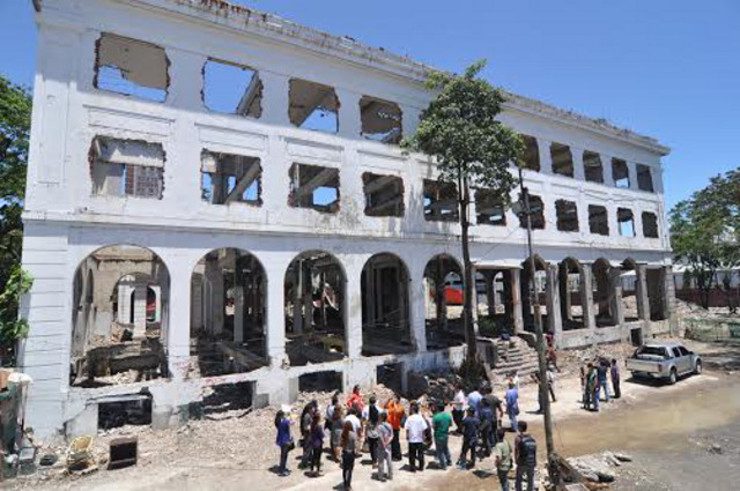SUMMARY
This is AI generated summarization, which may have errors. For context, always refer to the full article.

MANILA, Philippines – If the recent controversies regarding historical and cultural sites are any indication, national government agencies with relevant mandates are in need of a major overhaul.
This was the conclusion of certain members of the House of Representatives after a hearing on Monday, October 27.
The omnibus hearing looked into all the recent issues concerning heritage sites and culturally-important structures in Manila such as the construction of DMCI’s Torre de Manila, the development of the Army Navy Club and Admiral Hotel and another planned real estate development in the historic Santa Ana district.
The hearing was attended by real estate developers involved, heritage advocates and officials from the National Historical Commission of the Philippines (NHCP), National Commission on Culture and the Arts (NCCA) and the National Museum.
The last 3 are the national government agencies mandated to protect and conserve historically and culturally-significant sites and structures all over the country.
But its the hazy arrangement and inner workings of these agencies that may have allowed the controversies to take place, said some congressmen.
“The main problem is coordination, number one. Number two, their jurisdictional arrangements are not clear,” ABAKA party list Representative Jonathan Dela Cruz told Rappler after the hearing.
Passing the buck around
These problems became apparent in the interpellation of resource persons during the hearing.
For Torre de Manila, NHCP said it had no power to stop construction because the property was outside the buffer zone surrounding Rizal Park. But it was later on established that NHCP in fact had full authority to extend the buffer zone to limit the height of buildings behind the Rizal Monument.
Torre de Manila is now 23 floors high or half the height of its total 46 floors, said DMCI Homes legal counsel Leonid Nolasco.
In Santa Ana district, declared by NHCP as a heritage zone because of the area’s roots in prehistory, jurisdiction was passed from one agency to another.
CDC Holdings plans to put up a two-tower residential development in the area. NHCP had first relinquished their power to decide on the case because it said the buildings are outside the heritage zone.
The National Museum also gave clearance to CDC Holdings, saying the property had no archaeological significance, said CDC Holdings president Melissa Chua. The museum also gave the developer a list of guidelines so that construction would not endanger surrounding archaeological sites.
The NCCA, the last cultural agency, issued a cease and desist order (CDO) last October 7 to temporarily stop the development so it could assess whether or not the property had any significance, said NCCA lawyer Trixie Angeles.
Then the National Museum reasserted its jurisdiction over the area by issuing a show cause order because CDC Holdings did not abide by their guidelines.
The same relay game was apparent in the case of Admiral Hotel, a prewar structure that was once visited by American Generals Douglas MacArthur and Dwight Eisenhower, according to local historians.
The hotel was bought by Anchor Land Holdings Inc with plans to restore it as a boutique hotel.
NHCP, after telling Anchor Land that no historical events transpired in the hotel, referred the matter to the National Museum which is supposed to be in charge of “culturally-important property,” said NHCP deputy executive director Carminda Arevalo.
Need to simplify
The decisions of the 3 agencies, often in conflict with another, only drag out controversies without decisive action being taken to save the historic or cultural structures.
The process needs to be simplified, said some congressmen present.
“There should be a singular agency to serve as a clearing house on all of these things. When you look at the law, it’s very ambiguous,” Kabataan Party List Representative Terry Ridon told Rappler.
According to the National Cultural Heritage Act of 2009, “cultural property” should be put under the National Museum while anything relating to “Philippine history” should be lodged with the NHCP (formerly known as the National Historical Institute).
Any site or structure only presumed to be significant (meaning no historical marker yet) falls under the NCCA.
But what happens when a site is both historically and culturally important? And who will police agencies that relinquish their jurisdiction over structures that, based on the law, are theirs to protect?
The messy situation victimizes developers who may have good intentions in redeveloping the property.
Developers like Oceanville Corporation (Army Navy Club developer) and Anchor Land Holdings Inc, for example, sought the advice of NHCP before beginning their work. Both companies also promised to preserve the characteristics of the old buildings they are touching.
That’s why some congressmen are recommending that the agencies come up with a checklist for developers to follow.
“I think most developers don’t know what to do when they’re faced with historical buildings and cultural buildings. They don’t really know they have to get some permits from major national agencies,” said Ridon.
The hearing is the first time the Lower House is dipping its fingers into the recent controversies concerning Manila City’s historical and cultural sites.
In the Senate, Senator Pia Cayetano has called hearings on Torre de Manila and the Army Navy Club. She had concluded then that legislation may be needed to strengthen the ability of cultural agencies to fulfill their mandate. – Rappler.com
Add a comment
How does this make you feel?
There are no comments yet. Add your comment to start the conversation.